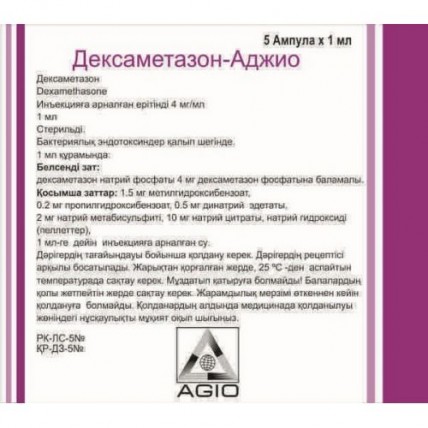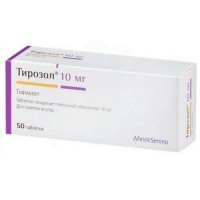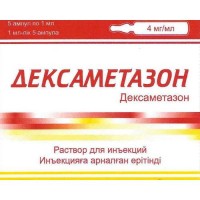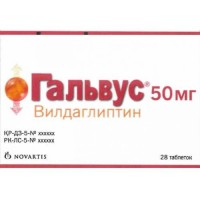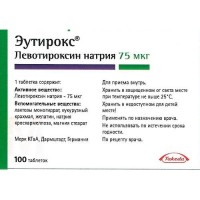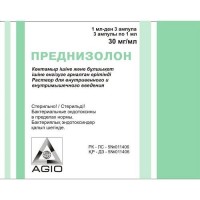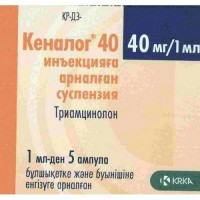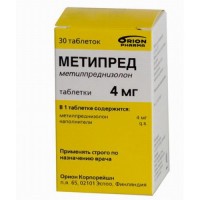Dexamethasone-Adzhio 4 mg / ml 1 ml 25's solution for injection in ampoules
- $13.90
The instruction for medical use of Deksametazon-Adzhio Torgovoye medicine a name of Deksametazon-Adzhio the International unlicensed name Dexamethasone Dosage Form Solution for injections of 4 mg/ml, 1 ml Structure Structure on 1 ml of drug: active agent of Dexamethasone of sodium phosphate (it is equivalent dexamethasone to phosphate) 4 mg excipients: methylhydroxybenzoate of 1.5 mg, propilgidroksibenzoat 0.2 mg, dinatrium edetat 0.5 mg, sodium metabisulphite of 2 mg, sodium citrate of 10 mg, sodium hydroxide (pellets), water for injections up to 1 ml the Description Transparent solution from colourless till pale yellow color. Pharmacotherapeutic group Hormonal drugs for system use. Corticosteroids for system use. Glucocorticosteroids. Dexamethasone. The ATX H02AB02 code the Pharmacological Pharmacokinetics Later properties of administration of solution of dexamethasone for sodium dexamethasone injections phosphate is quickly hydrolyzed to dexamethasone. After the IV dose of 20 mg of dexamethasone the level in plasma reaches peak within 5 minutes. Dexamethasone is connected (up to 77%) with proteins of plasma mainly albumine. There is a high absorption of dexamethasone a liver, kidneys and adrenal glands. Metabolism in a liver slow, and excretion happens mainly in urine, generally in the form of not conjugated steroids. The half-life period in plasma is 3.5 - 4.5 hours, but as effects go beyond considerable concentration of steroids in plasma, the half-life period in plasma has smaller value, and use of a biological half-life period is more applicable. The biological half-life period of dexamethasone is 36 - 54 hours, For this reason dexamethasone especially approaches in cases of continuous glucocorticoid action. The pharmacodynamics Dexamethasone is a synthetic adrenokortikoid with approximately by 7 times higher anti-inflammatory activity, than at Prednisolonum, and in 30 times more, than at a hydrocortisone. Adrenokortikoida affect GPA at specific receptors on a plasma membrane. On other fabrics of an adrenokortikoida extend through cellular membranes and connect to specific cytoplasmatic receptors which enter a cellular kernel and stimulate protein synthesis. Adrenokortikoida have antiallergenic, anti-toxic, antishock, febrifugal and immunosuppressive properties. Dexamethasone has only insignificant mineralokortikoidny activity and therefore does not cause deduction of water and sodium. Indications - solution for injections of dexamethasone can be used for local and system therapy in all acute conditions at which intravenous administration of glucocorticoids can be vital. Route of administration and doses Dosing Note: All recommendations about a dosage specified in this section are expressed as mg on the basis of dexamethasone. In general the dosage of glucocorticoids depends on weight of a state and reaction of the patient. Under certain circumstances, for example in a stress, additional doses can be required. If within several days the favorable reaction was not noted, therapy by glucocorticoids should be stopped. Adult and elderly patients After the disease is taken under control, the dosage should be reduced or lowered to minimum necessary level at constant observation of the patient. At critical life-threatening situations (for example, an anaphylaxis, acute heavy asthma) significantly higher doses can be required. Brain hypostasis (at adults): the initial dose makes 8-16 mg in/in, then 5 mg in/in or each 6 hours in oil before obtaining satisfactory result. In brain surgery these doses can be required within several days after operation. After that the dosage needs to be reduced gradually. Increase in the intracranial pressure connected with brain tumors can be controlled continuous treatment. For topical treatment the following doses can be recommended: • vnutrisustavno: 1.6 - 3 mg large joints of 0.6 - 0.8 mg small joints • intrabursalno: 1.6 - 3 mg, • in tendinous covers of 0.3 - 0.8 mg the Frequency of injections can vary from each 3-5 days to each 2-3 weeks. At a drop enema in cases of ulcer colitis: 4 mg part in 120 ml of normal saline solution. The recommended doses for children of the Requirement to a dosage are variables and can be changed according to individual requirements. The usual dose makes from 0.2 mg/kg to 0.4 mg/kg of body weight a day. The route of administration Dexamethasone solution for injections can be entered intravenously, subcutaneously, intramusculary, by a local injection or in the form of a drop enema. For introduction by intravenous injection: see the section on compatibility with infusional liquids. At intravenous administration it is possible to receive quickly high levels in plasma. The fast intravenous injection of high doses of glucocorticoids can sometimes result in cardiovascular insufficiency therefore the injection needs to be entered slowly within several minutes. It is necessary to appoint intra articulate injections in strictly aseptic conditions. Side effects Local side reactions include the inflammation arising after an injection and the disturbance of joints similar to Sharko's arthropathy, especially at a repeated intra articulate injection. Frequency of predictable undesirable effects, including suppression gipotalamo - hypophysial adrenal glands, correlates with relative efficiency of drug, a dosage, time of introduction and lasting treatments. There are messages about cases of ruptures of sinews. The local injection of glucocorticoids can result in system effects. An endocrine / metabolic system - suppression gipotalamo - a hypophysial and adrenal axis, premature closing of an epiphysis, suppression of growth in infancy, the childhood and teenage age, disturbance of a menstrual cycle and an amenorrhea, Cushing's syndrome, a hirsutism, increase in weight, disturbance of tolerance to carbohydrates with the increased need for anti-diabetic therapy, disturbance of balance of protein and calcium, the increased appetite Anti-inflammatory and immunosuppressive action - the increased susceptibility and weight of infections with suppression of clinical symptoms and signs, reduction of adenoid tissue and immune effect, opportunistic infections, a recurrence of the sleeping tuberculosis and decrease in sensitivity to vaccination and skin tests. The musculoskeletal system - osteoporosis, fractures of vertebras and long bones, an avascular osteonecrosis, a rupture of sinews - a proximal myopathy Disturbance of balance of liquid and electrolytes - deduction of sodium and water, a hypertension, potassium loss, a gipokaliyemichesky alkalosis Neuropsychiatric - a wide range of psychiatric reactions, including affective disorders (such as irritable, euphoric, suppressed and labile mood, suicide thoughts), psychotic reactions (including a mania, nonsense, hallucinations and exacerbation of schizophrenia), behavioural disorders, irritability, concern, sleep disorders and cognitive dysfunction, including confusion of consciousness and amnesia. Reactions are the general and can have to arise both at adults, and at children. At adults the frequency of heavy reactions is estimated at 5-6%. It was reported about psychological consequences after cancellation of corticosteroids, Frequency is unknown. - the increased intracranial pressure with papilloedemy at children (pseudotumour cerebri), as a rule, after treatment cancellation, aggravation of epilepsy, psychological dependence. Ophthalmologic - the increased intraocular pressure, glaucoma, a papilloedema, a back subkapsulyarny cataract, thinning of a cornea or sclera, exacerbation of ophthalmologic viral or fungus diseases. Digestive tract - dyspepsia, a round ulcer with perforation and bleeding, acute pancreatitis, kandidozirovanny Dermatological - disturbance of healing of wounds, a skin atrophy, bruises, a teleangiectasia, striya, increase in sweating, appearance of acne rash. The general - are available messages about hypersensitivity, including an anaphylaxis. Leukocytosis. Thrombembolia. - short-term burning or pricking generally in a crotch after intravenous administration of high doses of corticosteroid phosphates. - symptoms and signs after the therapy termination - too fast dose decline of corticosteroids after long-term treatment can result in acute adrenal insufficiency, hypotonia and a lethal outcome. - also appearance of "withdrawal", including fever, myalgia, an arthralgia, rhinitis, conjunctivitis, painful pruritic concretions of skin and loss of weight is possible. Contraindications · A system infection if specific anti-infectious therapy is not performed. · Hypersensitivity to any ingredient. · The local injection of a glucocorticoid is contraindicated in bacteremia and system fungal infections, unstable joints, an infection in the place of an injection, for example, the septic arthritis caused by gonorrhea or tuberculosis. Medicinal interactions Rifampicin, rifabutin, ephedrine, carbamazepine, phenylbutazone, phenobarbital, Phenytoinum, Primidonum and aminoglutethimide strengthen metabolism of corticosteroids owing to what their therapeutic effect can be reduced. Dexamethasone is moderate inductor CYP 3A4. Joint administration of dexamethasone with other medicines which are metabolized by means of CYP 3A4 (for example, an indinavira, erythromycin) can increase their clearance that leads to decrease in concentration in plasma. Effects of anti-cholinesterases antagonizirutsya by corticosteroids at a myasthenia. Desirable effects of hypoglycemic agents (including insulin), anti-hypertensia, cardiac glycosides and diuretics antagonizirutsya by corticosteroids, and gipokaliyemichesky effects of acetazoleamide, loopback diuretics, thiazide diuretics and a karbenoksolon amplify. The efficiency of coumarinic anticoagulants can be increased by simultaneous therapy by corticosteroids, and prevention of spontaneous bleeding requires careful monitoring of INR or a prothrombin time. The renal clearance of salicylates increases corticosteroids, and cancellation of use of steroids can lead to intoxication salicylate. There can be an interaction with salicylates for patients with a prothrombinopenia. The special instructions Experience of Post-registration Use were very seldom shown by a syndrome of lysis of a tumor (TLS) at patients with hematologic malignant new growths after dexamethasone use separately or in a combination with other chemotherapeutic agents. Patients with high risk TLS should be controlled and taken carefully for them the appropriate measures of precaution. Patients and/or trustees should be warned that potentially heavy psychiatric side reactions can arise at administration of system steroids. Symptoms usually appear within several days or weeks after an initiation of treatment. Risks can be higher at high doses / system influence though levels of a dose do not allow to predict the beginning, weight or duration of reactions. The majority of reactions stop after a dose decline or cancellation of introduction though specific treatment can be required. Patients/trustees should ask for medical care if they have psychological symptoms, especially a depression or suicide thoughts. Patients/trustees also have to be attentive to possible mental disorders which can arise in time or right after decrease in dose/cancellation of system steroids though such reactions are registered seldom. The extra care is required by consideration of a question of use of system corticosteroids from patients with the existing or previous story of heavy affective disorders at itself or at relatives of the first line. Depressive or manic-depressive psychosis and the previous steroid psychosis concern them. The undesirable phenomena can be minimized, using the lowest effective dose during the minimum period and entering the daily need for a type of a single morning dose or when it is possible, in the form of a single morning dose in alternative days. Appropriate titration of a dose against activity of a disease requires frequent survey of the patient. After parenteral administration of glucocorticoids, serious anaphylactoid reactions, such as laryngeal edema, small tortoiseshell and bronchospasm, especially at patients with allergology are sometimes observed. If there is such anaphylactoid reaction, the patient is treated adrenaline and a supply and exhaust ventilation. Corticosteroids cannot be used for treatment of injuries of the head or a stroke as they will hardly bring benefit, and will do much harm rather. Results of a research indicate increase in mortality if therapy by Methylprednisolonum begins more than two weeks later after acute onset of the respiratory distress syndrome of adults (RDSA). Thus, treatment of RDSV corticosteroids has to be begun within the first two weeks after the beginning of RDSV. The premature newborn Available data confirm the long-term undesirable phenomena in nervous system after early treatment (& lt, 96 hours) premature children with a chronic disease of lungs at initial doses of 0.25 mg/kg twice a day. Dexamethasone cancellation the Atrophy of bark of adrenal glands develops during long therapy and can remain for many years after the treatment termination. Therefore cancellation of corticosteroids after long therapy always has to be gradual to avoid acute adrenal insufficiency, and to decrease within several weeks or months depending on a dose and duration of treatment. For the patients receiving above physiological doses of system corticosteroids (about 1 mg of dexamethasone) within more than 3 weeks, cancellation should not be cutting. As the dose decline has to be carried out, in many respects depends on whether can recur a disease when the dose of system corticosteroids decreases. During cancellation clinical assessment of activity of a disease can be required. If the recurrence of a disease is improbable after cancellation of system corticosteroids, but there is an uncertainty concerning suppression of HPA, a dose of a system corticosteroid it has to is possible to reduce quickly to physiological 1 mg of dexamethasone dosed After achievement of a daily dose a dose decline to be slower that it was possible to restore gipotalamo - a hypophysial and adrenal axis. Sharp cancellation of system treatment by corticosteroids which continued up to 3 weeks is reasonable if it is considered that the palindromia is improbable. Sharp decrease in doses of dexamethasone to 6 mg a day within 3 weeks will hardly lead to clinically significant suppression gipotalamo - a hypophysial and adrenal axis at most of patients. In the following groups of patients corticosteroids it is necessary to consider gradual withdrawal of system therapy even after courses lasting 3 weeks or less: • The patients taking repeated courses of system corticosteroids, especially at introduction more than 3 weeks. • If within a year after the termination of long therapy (months or years) the short course was appointed. • Patients who can have other reasons of development of insufficiency of bark of adrenal glands, except exogenous therapy by corticosteroids. • The patients receiving doses of a system corticosteroid more than 6 mg in day of dexamethasone. • The patients who were repeatedly accepting evening doses. At long therapy any intercurrent disease, an injury or surgical intervention will demand temporary increase in a dosage if introduction of corticosteroids was are stopped after long therapy, them, perhaps, it will be necessary to enter temporarily repeatedly. Patients have to have cards of "steroid treatment" where accurate instructions concerning precautionary measures which need to be taken into consideration for minimization of risk and which provide detailed information on the appointed drug, a dosage and duration of treatment are given. Anti-inflammatory/immunosuppressive action and infections Suppression of the inflammatory answer and immune function increases susceptibility to infections and their gravity. The clinical picture can often be atypical, and serious infections, such as septicaemia and tuberculosis, can be disguised and reach a late stage before they are identified. At N
of an obkhodimost the corresponding antimicrobic therapy has to accompany treatment with glucocorticoids, for example, in tuberculosis and also viral and fungal infections of eyes. Chicken pox causes special concern as this usually insignificant disease can be fatal to patients with the weakened immunity. Patients (or to parents of children) without certain history of chicken pox should advise to avoid close personal contact with patients with chicken pox or the surrounding herpes, and if they are affected, they should ask for emergency medical service. Passive immunization with immunoglobulin is necessary for patients with the weakened immunity who receive system corticosteroids or which used them within the last 3 months for serotherapy of chicken pox (VZIG), it should be carried out within 10 days after influence of chicken pox. If the diagnosis of chicken pox is confirmed, the disease demands the specialized help and urgent treatment. It is not necessary to stop introduction of corticosteroids, and a dose, perhaps, it is necessary to increase. Measles. Patients should recommend to show extra care for avoidance of influence of measles and to ask for emergency medical service in case of contact with measles, prevention with maintaining a normal immunoglobin intramusculary can be required. Persons should not appoint live vaccines with the weakened immune response. Reaction of antibodies to other vaccines can be reduced. Special precautionary measures the Extra care and frequent monitoring is required by consideration of a question of use of system corticosteroids from patients with the following states: a. Osteoporosis (women in the postclimacteric period are especially subject), b. A hypertension or stagnant heart failure, with. The existing or previous history of heavy affective disorders (especially previous steroid psychosis), d. Diabetes (or family history of diabetes), e. Tuberculosis history as glucocorticoids can cause reactivation, f. Glaucoma (or family history of glaucoma), g. The previous myopathy caused by corticosteroids, h. Liver failure, i. Renal failure, J. Epilepsy, k. Gastrointestinal ulceration, l. Migraine, m. Some parasitic invasions, in particular, amebiasis, n. Incomplete natural growth as glucocorticoids at long reception can accelerate epiphyseal closing, o. Patients with Cushing's syndrome, At treatment of such states as a tendinitis or a tendovaginitis, it is necessary to take precautionary measures at introduction to space between tendinous a vagina and a sinew as it was reported about cases of a rupture of a sinew. Use for children Corticosteroids cause the growth inhibition connected with a dose, in infancy, the childhood and youth, able to be irreversible. Dexamethasone is used for treatment and prevention of chronic diseases of lungs at premature newborns. Clinical trials showed short-term advantage in decrease in dependence on IVL, but did not give long-term advantages in reduction of time of an extract, decrease in prevalence of chronic diseases of lungs or mortality. Recent researches showed communication between use of dexamethasone at premature children and development of a cerebral palsy. Taking it into account, assessment advantage risk has to be calculated on an individual basis. Use at elderly people the General undesirable phenomena of system corticosteroids can be connected with more serious consequences at advanced age, especially osteoporosis, a hypertension, a hypopotassemia, diabetes, susceptibility to an infection and thinning of skin. To avoid life-threatening reactions, careful clinical supervision is required. Pregnancy Ability of corticosteroids to get through a placenta varies between separate drugs, however dexamethasone easily passes a placenta. Introduction of corticosteroids to pregnant women can cause fetation disturbances, including splitting of the sky, a pre-natal growth inhibition and influence on growth and development of a brain. There are no proofs that corticosteroids lead to increase in number of congenital anomalies, such as splitting of skies / lips at the person. However when using drug for a long time or repeatedly during pregnancy the corticosteroids can increase risk of a delay of pre-natal development. The hypnoadrenalism can theoretically arise at newborns after pre-natal influence of corticosteroids, but usually it spontaneously disappears after the birth and seldom has clinical value. As well as other drugs, corticosteroids have to be appointed only when advantages to mother and the child outweigh risk of emergence of side effects. However, in case of need corticosteroids, it is possible to treat patients with normal pregnancy as well as other patients. A lactation Corticosteroids can get into breast milk though data on dexamethasone are absent. Babies whose mothers accepted high doses of system corticosteroids for a long time can have a suppression of adrenal glands. The feature of influence on ability to run the vehicle or potentially dangerous mechanisms does not matter. Overdose it is difficult to define a corticosteroid overdose as the therapeutic dose will vary depending on indications and needs of the patient. The high dose of corticosteroids of IV entered as an impulse in emergency situations, most likely, does not cause undesirable effects. There can be strengthening of the side effects connected with corticosteroids. Treatment has to be asymptomatic and supporting as required. The form of release and packing On 1 ml of drug place in glass ampoules of amber color. On 5 ampoules place in a ridge pallet. On 1 pallet together with the instruction for medical use in the state and Russian languages place a pack from cardboard. 5 packs place in a box of cardboard. Storage conditions In the place protected from light, at a temperature not above 25 °C. Not to freeze. To store out of children's reach! 2 years not to apply a period of storage after an expiration date. Prescription status According to the prescription of Proizvoditel Adzhio Pharmatsevtikalz Ltd, India H.O.: A-38, Nandjyot Industrial Estate, Kurla - Andheri Road, Safedpool, Mumbai – 400,072 Owner of the registration certificate of Adzhio Pharmatsevtikalz Ltd, Mumbai, India the Name, the address and a contact information of the organization accepting in the territory of the Republic of Kazakhstan claims from consumers on quality of products (goods) of Predstavitelstvo kompanii Adzhio Pharmatsevtikalz Limited in RK 050000 Almaty Dostyk St., 43, office 414 phone number: +7727-339-01-05 koulvishwaagiokazak@gmail.com Name, address and contact information of the organization, responsible for post-registration observation of safety of TOO "SonsultAsia" Shevchenko St. medicine of 165 B of E-mail: registration@consultingasia.kz pv@consultingasia.kz Ph. / fax: +7727-379-42-58 +77051708825
To develop
of an obkhodimost the corresponding antimicrobic therapy has to accompany treatment with glucocorticoids, for example, in tuberculosis and also viral and fungal infections of eyes. Chicken pox causes special concern as this usually insignificant disease can be fatal to patients with the weakened immunity. Patients (or to parents of children) without certain history of chicken pox should advise to avoid close personal contact with patients with chicken pox or the surrounding herpes, and if they are affected, they should ask for emergency medical service. Passive immunization with immunoglobulin is necessary for patients with the weakened immunity who receive system corticosteroids or which used them within the last 3 months for serotherapy of chicken pox (VZIG), it should be carried out within 10 days after influence of chicken pox. If the diagnosis of chicken pox is confirmed, the disease demands the specialized help and urgent treatment. It is not necessary to stop introduction of corticosteroids, and a dose, perhaps, it is necessary to increase. Measles. Patients should recommend to show extra care for avoidance of influence of measles and to ask for emergency medical service in case of contact with measles, prevention with maintaining a normal immunoglobin intramusculary can be required. Persons should not appoint live vaccines with the weakened immune response. Reaction of antibodies to other vaccines can be reduced. Special precautionary measures the Extra care and frequent monitoring is required by consideration of a question of use of system corticosteroids from patients with the following states: a. Osteoporosis (women in the postclimacteric period are especially subject), b. A hypertension or stagnant heart failure, with. The existing or previous history of heavy affective disorders (especially previous steroid psychosis), d. Diabetes (or family history of diabetes), e. Tuberculosis history as glucocorticoids can cause reactivation, f. Glaucoma (or family history of glaucoma), g. The previous myopathy caused by corticosteroids, h. Liver failure, i. Renal failure, J. Epilepsy, k. Gastrointestinal ulceration, l. Migraine, m. Some parasitic invasions, in particular, amebiasis, n. Incomplete natural growth as glucocorticoids at long reception can accelerate epiphyseal closing, o. Patients with Cushing's syndrome, At treatment of such states as a tendinitis or a tendovaginitis, it is necessary to take precautionary measures at introduction to space between tendinous a vagina and a sinew as it was reported about cases of a rupture of a sinew. Use for children Corticosteroids cause the growth inhibition connected with a dose, in infancy, the childhood and youth, able to be irreversible. Dexamethasone is used for treatment and prevention of chronic diseases of lungs at premature newborns. Clinical trials showed short-term advantage in decrease in dependence on IVL, but did not give long-term advantages in reduction of time of an extract, decrease in prevalence of chronic diseases of lungs or mortality. Recent researches showed communication between use of dexamethasone at premature children and development of a cerebral palsy. Taking it into account, assessment advantage risk has to be calculated on an individual basis. Use at elderly people the General undesirable phenomena of system corticosteroids can be connected with more serious consequences at advanced age, especially osteoporosis, a hypertension, a hypopotassemia, diabetes, susceptibility to an infection and thinning of skin. To avoid life-threatening reactions, careful clinical supervision is required. Pregnancy Ability of corticosteroids to get through a placenta varies between separate drugs, however dexamethasone easily passes a placenta. Introduction of corticosteroids to pregnant women can cause fetation disturbances, including splitting of the sky, a pre-natal growth inhibition and influence on growth and development of a brain. There are no proofs that corticosteroids lead to increase in number of congenital anomalies, such as splitting of skies / lips at the person. However when using drug for a long time or repeatedly during pregnancy the corticosteroids can increase risk of a delay of pre-natal development. The hypnoadrenalism can theoretically arise at newborns after pre-natal influence of corticosteroids, but usually it spontaneously disappears after the birth and seldom has clinical value. As well as other drugs, corticosteroids have to be appointed only when advantages to mother and the child outweigh risk of emergence of side effects. However, in case of need corticosteroids, it is possible to treat patients with normal pregnancy as well as other patients. A lactation Corticosteroids can get into breast milk though data on dexamethasone are absent. Babies whose mothers accepted high doses of system corticosteroids for a long time can have a suppression of adrenal glands. The feature of influence on ability to run the vehicle or potentially dangerous mechanisms does not matter. Overdose it is difficult to define a corticosteroid overdose as the therapeutic dose will vary depending on indications and needs of the patient. The high dose of corticosteroids of IV entered as an impulse in emergency situations, most likely, does not cause undesirable effects. There can be strengthening of the side effects connected with corticosteroids. Treatment has to be asymptomatic and supporting as required. The form of release and packing On 1 ml of drug place in glass ampoules of amber color. On 5 ampoules place in a ridge pallet. On 1 pallet together with the instruction for medical use in the state and Russian languages place a pack from cardboard. 5 packs place in a box of cardboard. Storage conditions In the place protected from light, at a temperature not above 25 °C. Not to freeze. To store out of children's reach! 2 years not to apply a period of storage after an expiration date. Prescription status According to the prescription of Proizvoditel Adzhio Pharmatsevtikalz Ltd, India H.O.: A-38, Nandjyot Industrial Estate, Kurla - Andheri Road, Safedpool, Mumbai – 400,072 Owner of the registration certificate of Adzhio Pharmatsevtikalz Ltd, Mumbai, India the Name, the address and a contact information of the organization accepting in the territory of the Republic of Kazakhstan claims from consumers on quality of products (goods) of Predstavitelstvo kompanii Adzhio Pharmatsevtikalz Limited in RK 050000 Almaty Dostyk St., 43, office 414 phone number: +7727-339-01-05 koulvishwaagiokazak@gmail.com Name, address and contact information of the organization, responsible for post-registration observation of safety of TOO "SonsultAsia" Shevchenko St. medicine of 165 B of E-mail: registration@consultingasia.kz pv@consultingasia.kz Ph. / fax: +7727-379-42-58 +77051708825
To develop
